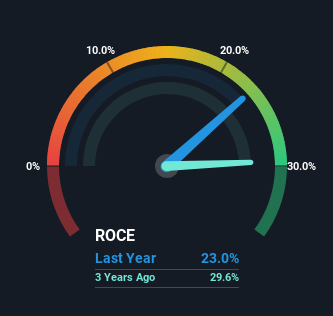
Did you know there are some financial metrics that can provide clues of a potential multi-bagger? Amongst other things, we’ll want to see two things; firstly, a growing return on capital employed (ROCE) and secondly, an expansion in the company’s amount of capital employed. Basically this means that a company has profitable initiatives that it can continue to reinvest in, which is a trait of a compounding machine. Speaking of which, we noticed some great changes in Dr. Martens’ (LON:DOCS) returns on capital, so let’s have a look.
What Is Return On Capital Employed (ROCE)?
Just to clarify if you’re unsure, ROCE is a metric for evaluating how much pre-tax income (in percentage terms) a company earns on the capital invested in its business. To calculate this metric for Dr. Martens, this is the formula:
Return on Capital Employed = Earnings Before Interest and Tax (EBIT) ÷ (Total Assets – Current Liabilities)
0.23 = UK£191m ÷ (UK£993m – UK£165m) (Based on the trailing twelve months to March 2023).
So, Dr. Martens has an ROCE of 23%. That’s a fantastic return and not only that, it outpaces the average of 8.7% earned by companies in a similar industry.
See our latest analysis for Dr. Martens
Above you can see how the current ROCE for Dr. Martens compares to its prior returns on capital, but there’s only so much you can tell from the past. If you’d like, you can check out the forecasts from the analysts covering Dr. Martens here for free.
The Trend Of ROCE
We like the trends that we’re seeing from Dr. Martens. The data shows that returns on capital have increased substantially over the last five years to 23%. The amount of capital employed has increased too, by 112%. The increasing returns on a growing amount of capital is common amongst multi-baggers and that’s why we’re impressed.
In Conclusion…
In summary, it’s great to see that Dr. Martens can compound returns by consistently reinvesting capital at increasing rates of return, because these are some of the key ingredients of those highly sought after multi-baggers. Given the stock has declined 46% in the last year, this could be a good investment if the valuation and other metrics are also appealing. So researching this company further and determining whether or not these trends will continue seems justified.
If you want to know some of the risks facing Dr. Martens we’ve found 4 warning signs (2 are a bit concerning!) that you should be aware of before investing here.
If you want to search for more stocks that have been earning high returns, check out this free list of stocks with solid balance sheets that are also earning high returns on equity.
Have feedback on this article? Concerned about the content? Get in touch with us directly. Alternatively, email editorial-team (at) simplywallst.com.
This article by Simply Wall St is general in nature. We provide commentary based on historical data and analyst forecasts only using an unbiased methodology and our articles are not intended to be financial advice. It does not constitute a recommendation to buy or sell any stock, and does not take account of your objectives, or your financial situation. We aim to bring you long-term focused analysis driven by fundamental data. Note that our analysis may not factor in the latest price-sensitive company announcements or qualitative material. Simply Wall St has no position in any stocks mentioned.







